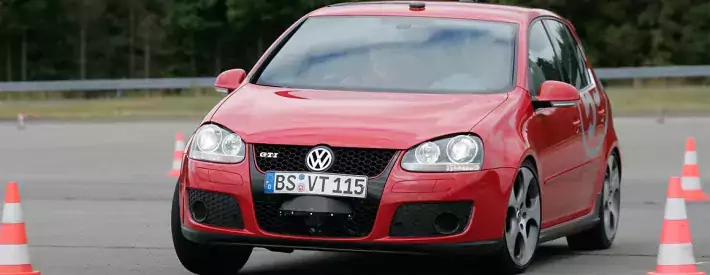The Gadget Show’s Jon Bentley lets a VW Golf take control

In this article: The day TV presenter Jon Bentley sat behind the wheel of one of Volkswagen’s first autonomous vehicles
I’ve been lucky to spend my working life immersed in two of my biggest childhood passions – cars and technology. One consequence is that I often find myself being asked two questions: what’s your favourite car, and what’s the best gadget you’ve ever tested? I find them both almost impossible to answer.
The truthful response to the first is that you probably want a whole range of cars, all maintained perfectly and ready to go. That would include, say, a Range Rover for luxurious off-road picnics, design classics such as a ’59 Cadillac or a Citroën 2CV, and a Lotus Elise or a Porsche Cayman for when tactile satisfaction is a priority.
Deciding upon the drive of my life is a similarly difficult conundrum. Despite TV shows and recreational tour organisers thinking nothing of sending people to blat about Madagascar, the Himalayas or South America, I haven’t actually completed any epically long drives in exotic places. Even so, I do have a few possibilities to choose from. A 1,700-mile drive I made in 1993, retracing the route of the 1913 Alpine Trial on its 80th anniversary, is a strong candidate. Who wouldn’t want to be part of a convoy of forty Rolls-Royce Ghosts driving through spectacular scenery and witnessing the venerable cars being driven with enthusiasm up unsurfaced Alpine passes?
Equally, I could choose a sprint down an Autobahn near Stuttgart at 190mph in a Porsche 959 back in 1986, the first time I drove a Ferrari, or the occasion, much more recently, when The Gadget Show and the Alfa Romeo Owners Club arranged for me to drive an Alfa Romeo SZ, a car I’d long admired but never actually got to sample. All those drives were brilliantly enjoyable, but somehow they don’t quite feel significant enough.
The drive of my life so far, then, is one where I wasn’t actually driving. In fact, nobody was. It was 2006, I was a presenter on Fifth Gear, and Paul Bucket, then the PR boss of Volkswagen in the UK, called up and said he’d seen something in Wolfsburg that we really must film: a VW Golf that drove itself. So I set off with producer James Woodroffe to Volkswagen’s rather austere company town and reported for filming at the nearby Ehra-Lessien test track.
This was nearly a decade before self-driving cars became part of mainstream conversation, and I have to admit my expectations weren’t very high. We were invited to lay out a course of our choice with cones, and the car would apparently follow it. We then watched as a bright red Golf GTI inched its way around the course, learning our chosen route.
Then came the surprise. The engineer, Gregor, invited me into the car, started it up and pressed go. The car launched itself at the course with total commitment and absolutely flat out, right at the very limits of its grip. It was like being driven by a phantom world-class rally driver; throttle, steering wheel and brakes all coordinating themselves as if by magic. A big red button could abort things if absolutely necessary, but it wasn’t. It was a breathtaking ride that inspired total confidence.
In retrospect, maybe I shouldn’t have been so surprised. Stanford University had used super accurate GPS, laser scanners and a boot full of computers, all fitted to the Golf, to great success the previous year. The same team had won the DARPA Grand Challenge, the US Department of Defense-funded autonomous vehicle competition, with an autonomous VW Touareg called Stanley.
Recent changes in car design had helped too. The drive-by-wire throttle, electro-hydraulic power steering, electronic stability control and a dual-clutch transmission had made converting the Golf much easier.
At the time, VW didn’t envisage the car taking to public roads. There wasn’t enough artificial intelligence on board to attempt that. Instead, the firm saw it more as a way of enabling autonomous endurance testing without the need for human test drivers. But in a way that was strangely prescient. The kinds of autonomous cars that are succeeding now seem to have much in common with that Golf. They do best in controlled areas, whether that means slow-moving pods on university campuses or faster vehicles on racetracks. Artificial intelligence is still struggling to make sense of
the chaotically complex task that is real-world driving.
For me, the demonstration also exposed one of the biggest weaknesses of partial autonomy – remembering what’s automated and what’s not. At the event, VW was also demonstrating a selfparking Touran and, still in awe of the Golf, I hadn’t realized that the system didn’t brake for itself at the end of steering you into a parallel parking space. I therefore sailed merrily into the car behind, fortunately at too low a speed to do any damage, but still fast enough to be thoroughly embarrassing.
My subsequent autonomous experiences haven’t really matched it. Cars intended for the public roads are necessarily slower and more cautious. Even the dedicated autonomous racers usually appear somehow less dramatic.
For its commitment, excitement and understated technological prowess, Wolfsburg 2006 is the top drive on my list.




